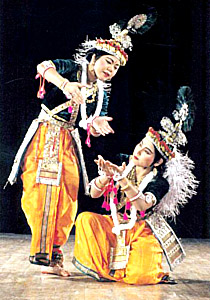 Theatre companies in Manipur have played a vital role in patronising the art of theatre and drama in the state. A long period of independence under the Ningthouja dynasty since the early Christian era helped Manipur to develop its political and cultural features. The ethnic majority of the state is the Meiteis clan who converted to Hinduism in the eighteenth century and indigenous faiths and beliefs survived under the surface, having contributed to Manipuri artistic expression. The Meitei had encouraged the growth of theatre in the state, while the hill tribes provided rich textures of music and dance.
Theatre companies in Manipur have played a vital role in patronising the art of theatre and drama in the state. A long period of independence under the Ningthouja dynasty since the early Christian era helped Manipur to develop its political and cultural features. The ethnic majority of the state is the Meiteis clan who converted to Hinduism in the eighteenth century and indigenous faiths and beliefs survived under the surface, having contributed to Manipuri artistic expression. The Meitei had encouraged the growth of theatre in the state, while the hill tribes provided rich textures of music and dance.
The first permanent theatre company in Manipur was in the early years of first decade of 20th century in the form of Manipur Friends Dramatic Union. During this era plays were mainly Manipuri adaptation of Bangali plays. But 1925 saw the beginning of authentic Manipuri plays with "Narasingh". The theatre companies in Manipur played a major role to build the profound foundation of Manipuri plays. The growth of theatre companies in Manipur geared up with the institutions of various companies such as Manipur Dramatic Union (MDU) (1930), Arian Theatre (1935), Chitrangada Natya Mandir (1936), Society Theatre (1937), Rupmahal (1942), Cosmopolitan Dramatic Union (1968), The Chorus Repertory Theatre of Ratan Thiyam (1976) and many others. These theatre companies in Manipur started experimenting with various types of plays apart from historical and Puranic ones. As a result of the efforts taken by theatre companies in Manipur, people were encouraged to take active part in developing this art form.
Manipur Dramatic Union is the premier theatre company in Manipur and it was usually for the native Meitei people. It grew in unexpected circumstances to claim the nucleus position in Manipuri theatre. The cultural area of Yaiskul Pana houses many theatre companies in Manipur. These theatre companies in Manipur reflect vibrancy, glitter, colour and refined textures, refinement, and grace through their act of performances.